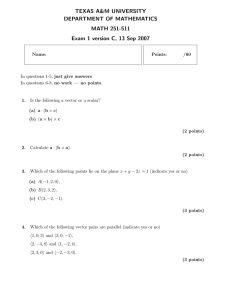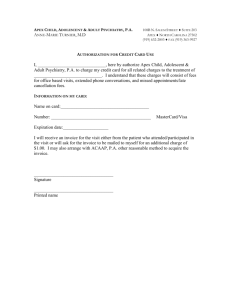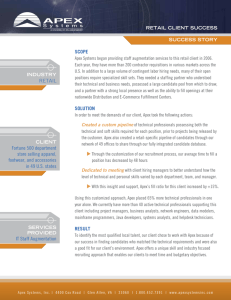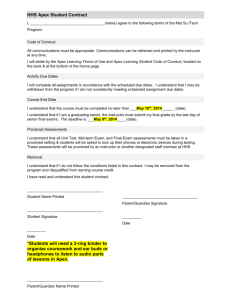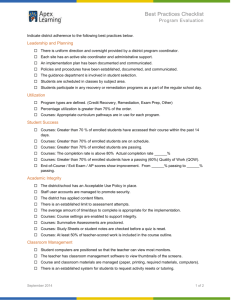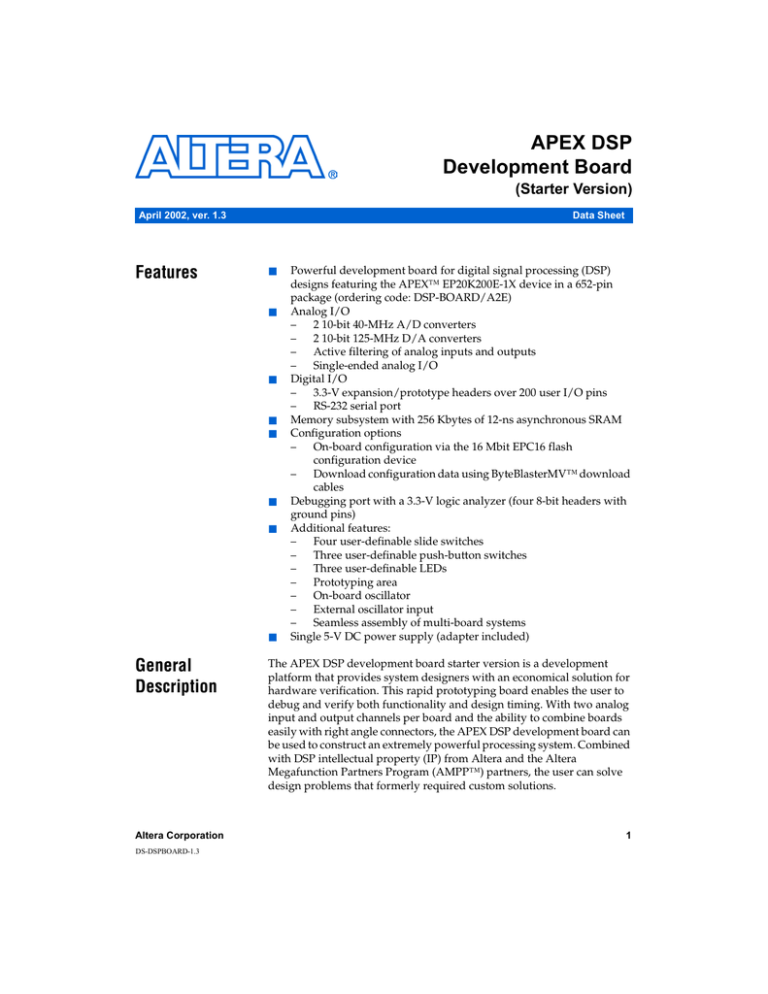
APEX DSP
Development Board
(Starter Version)
April 2002, ver. 1.3
Features
Data Sheet
■
■
■
■
■
■
■
■
General
Description
Altera Corporation
DS-DSPBOARD-1.3
Powerful development board for digital signal processing (DSP)
designs featuring the APEX™ EP20K200E-1X device in a 652-pin
package (ordering code: DSP-BOARD/A2E)
Analog I/O
–
2 10-bit 40-MHz A/D converters
–
2 10-bit 125-MHz D/A converters
–
Active filtering of analog inputs and outputs
–
Single-ended analog I/O
Digital I/O
–
3.3-V expansion/prototype headers over 200 user I/O pins
–
RS-232 serial port
Memory subsystem with 256 Kbytes of 12-ns asynchronous SRAM
Configuration options
–
On-board configuration via the 16 Mbit EPC16 flash
configuration device
–
Download configuration data using ByteBlasterMV™ download
cables
Debugging port with a 3.3-V logic analyzer (four 8-bit headers with
ground pins)
Additional features:
–
Four user-definable slide switches
–
Three user-definable push-button switches
–
Three user-definable LEDs
–
Prototyping area
–
On-board oscillator
–
External oscillator input
–
Seamless assembly of multi-board systems
Single 5-V DC power supply (adapter included)
The APEX DSP development board starter version is a development
platform that provides system designers with an economical solution for
hardware verification. This rapid prototyping board enables the user to
debug and verify both functionality and design timing. With two analog
input and output channels per board and the ability to combine boards
easily with right angle connectors, the APEX DSP development board can
be used to construct an extremely powerful processing system. Combined
with DSP intellectual property (IP) from Altera and the Altera
Megafunction Partners Program (AMPP™) partners, the user can solve
design problems that formerly required custom solutions.
1
APEX DSP Development Board (Starter Version) Data Sheet
The APEX DSP development board starter version includes an APEX
EP20K200E-1X device, a 10-bit analog I/O connector, and 256 KBytes of
memory.
Figure 1 shows a top view of the board.
Figure 1. APEX DSP Development Board
4 16-Pin Logic Analyzer
Headers (JP4, JP5, JP9 & JP10)
40-Pin Digital
I/O Connector (JP2)
60-Pin Digital
I/O Connector (JP1)
5-V Power
Supply (J1)
9-Pin RS-232
Connector (J7)
A/D 0 (J2)
JTAG Input for
APEX Device
Configuration (J8)
A/D 1 (J3)
JTAG Input for EPC16
Programming (JP7)
Prototyping Area
to Connect
Other Components
D/A 1 (J5)
External Clock
Input (J4)
D/A 0 (J6)
LEDs
2
40-Pin Digital
I/O Connector
(JP23)
60-Pin Digital I/O
Connector (JP24)
Slider
Switches
(SW3)
Push-Button Switches
(SW0 - SW2)
SW) Is the Master Reset
Altera Corporation
APEX DSP Development Board (Starter Version) Data Sheet
Interfaces
Table 1 describes the interfaces supported by the board.
Table 1. APEX DSP Development Board Interfaces
Interface
Type
Description
RS-232
I/O
The board has a 9-pin D connector, which can be configured as a DTE or
DCE serial port. The interface voltages are converted to 3.3-V signals and
brought to the APEX device, which must be configured to generate and
accept transmissions.
User I/O pins
I/O
The board has 150 general-purpose I/O pins on the 0.1” headers JP1, JP2,
JP23, and JP24.
Debug headers
I/O
The board has 32 general-purpose I/O pins on the .1” headers JP4, JP5,
JP9, and JP10. These pins are for use with an external logic analyzer.
Analog SMA connector Input
The board has 2 SMA connector inputs terminated in 50 Ω.
Analog SMA connector Output
The board has 2 SMA connector outputs with a source impedance of 50 Ω.
Prototyping area
The board provides a grid of plated through-holes on 0.1” centers. 30 APEX
I/O pins are connected to the grid.
I/O
Environmental Requirements
The development board must be stored between -40° C and 100° C. The
recommended operating temperature is between 0° C and 55° C.
1
Using the
Board
The board can be damaged without proper anti-static handling.
Therefore, you should take anti-static precautions before
handling the board.
The board ships programmed with a filtering design. Once power is
applied to the board, the POWER ON LED turns on. Next, the EPC16
configures the APEX device; successful configuration is indicated by the
CONF_DONE LED turning on.
To configure the board with a new design, the designer should perform
the following steps:
Altera Corporation
1.
Apply power.
2.
Configure the APEX device.
3.
Reset the board.
3
APEX DSP Development Board (Starter Version) Data Sheet
1. Apply Power
Power should be applied to the board by connecting the 5.0-V DC power
supply adapter provided in the DSP kit to connector J1 (see Figure 1 on
page 2). All of the board components are powered either directly from the
5.0-V supply or through 3.3-V and 1.8-V regulators powered from the
5.0-V supply.
■
■
The 3.3-V supply powers the APEX device and LVTTL board
components.
The 1.8-V supply provides VCCINT to the Altera APEX device.
When power is applied to the board, the POWER ON LED, D9, turns on.
2. Configure the APEX Device
After power-up, the EPC16 configuration device, which ships preprogrammed with a filtering design, automatically configures the
APEX 20KE device via a 10-pin header. The CONF_DONE LED turns on
signifying that the APEX device is configured.
To change the programming file in the device, the designer can program
the EPC16 device with the Quartus® II software and the ByteBlasterMV
cable and then turn power to the board off and then on again.
Alternatively, the designer can configure the APEX device directly—
without turning off the power—using the Quartus II software and the
ByteBlasterMV cable.
1
The designer can also use the Altera MasterBlaster™ cable to
program the EPC16 device or configure the APEX device.
However, this cable is not provided with the APEX DSP
Development Kit.
Configure the APEX Device with the EPC16 Device
New configuration data can be programmed into the EPC16 configuration
device, which configures the APEX device with the new data after power
to the board is cycled. The user can program the EPC16 device using the
Quartus II software version 2000.02 or higher using the ByteBlasterMV
cable connected to JP7 (see Figure 1 on page 2). In the Quartus II software,
select the JTAG mode and indicate which Programmer Object File (.pof)
to use for programming.
1
4
Be sure to connect pin 1 of the cable (indicated by a red stripe) to
pin 1 of the header on the board. See Figure 8 on page 21 for the
pin positions of the board header.
Altera Corporation
APEX DSP Development Board (Starter Version) Data Sheet
f
Refer to Quartus II Help for instructions on how to use the ByteBlasterMV
cable.
Configure the APEX Device Directly
The Quartus II software version 2000.02 or higher can configure the APEX
device directly via the ByteBlasterMV cable without cycling power to the
board. The cable connects to JP7 (see Figure 1 on page 2) on the board. In
the Quartus II software, select the JTAG mode and select the SRAM Object
File (.sof) generated by the software for configuration.
1
f
Be sure to connect pin 1 of the cable (indicated by a red stripe) to
pin 1 of the header on the board. See Figure 8 on page 21 for the
pin positions of the board header.
Refer to Quartus II Help for instructions on how to use the ByteBlasterMV
cable.
3. Reset the Board
The master reset switch, SW0, resets the APEX 20K device through the
DEV_CLRn input signal (if this reset mode is selected during compilation).
Alternatively, this pin can be used as a standard I/O pin to implement a
reset in a design.
1
Altera Corporation
SW0 is not a board-level reset. The APEX device should drive a
reset to any devices on the board that must be reset. This process
allows devices on the board to be reset independently from the
global reset without requiring additional hardware to prevent
contention.
5
APEX DSP Development Board (Starter Version) Data Sheet
Functional
Description
This section describes the elements of the DSP development board.
Figure shows a block diagram of the board.
Figure 2. APEX DSP Development Board Starter Version Block Diagram
A/D
Converter
LPF
A/D
Converter
LPF
10
37
37
64K × 16 SRAM
64K × 16 SRAM
10
Debug Headers
32
D/A
Converter
LPF
D/A
Converter
LPF
10
APEX
EP20K200E
Device
Prototyping Area
I/O Headers
10
150
RS-232
External Clock
40-MHz Oscillator
LEDs
JTAG Connector
5.0 V
JTAG Connector
VCCINT (1.8 V)
Regulators
EPC16
Slider
Switches
VCCIO (3.3-V)
Push-Button
Switches
APEX Device
The EP20K200E-1X device on the starter kit board features 211,000 gates
in a 652-pin FineLine BGA™ package. The device has 8,320 logic cells and
106,496 RAM bits.
f
6
For more information on APEX devices, go to the APEX 20K Programmable
Logic Device Family Data Sheet.
Altera Corporation
APEX DSP Development Board (Starter Version) Data Sheet
Table 2 describes the APEX device features.
Table 2. APEX Device Features
Feature
EP20K200EBC652-1X
Maximum gates (logic and RAM)
526,000
Typical gates
200,000
Logic elements (LEs)
8,320
Embedded system blocks (ESBs)
52
Maximum RAM bits
106,496
Maximum macrocells
832
Maximum user I/O pins
382
Internal supply voltage
1.8V
MultiVolt™ I/O interface voltage levels
3.3 V, 2.5 V
Package
652 BGA
I/O count
376
Board reference
U12
Voltage
1.8-V internal, 3.3-V I/O
EPC16 Configuration Device
Table 3 describes the EPC16 device features.
Table 3. EPC16 Reference
Item
Description
Board reference
U7
Part number
EPC16
Device description
16-Mbit Flash Configuration Device
Voltage
3.3-V
Manufacturer
Altera
Manufacturer web site
http://www.altera.com
A/D Converters
The APEX DSP development board has two A/D converters. The A/D
subsystem of the board has the following features:
■
■
Altera Corporation
The A/D converters produce 10-bit samples at a maximum rate of 40
MSPS.
The analog input to each A/D converter is single-ended.
7
APEX DSP Development Board (Starter Version) Data Sheet
■
■
■
■
■
■
The data output format to each A/D converter is two’s complement.
The voltage input range to each A/D converter is user-selectable at 1
VPP or 2 VPP (1 VPP is the default, see jumpers JP3 and JP15 in
Table 15).
The input to each A/D converter is user-selectable as AC coupled or
DC coupled (AC coupled is the default, see jumpers JP6 and JP16 in
Table 15).
The analog gain of each A/D converter input is user-selectable (an
analog gain = 1 is the default, see jumpers JP11 and JP17 in Table 15).
The A/D converter clock is user-selectable and can be the 40-MHz
oscillator or an external clock (the 40-MHz oscillator is the default, see
Jumper JP29 in Table 15).
Provides an out of range (OTR) output bit that indicates when the
input signal is beyond the A/D connector’s input range.
A signal travels through the A/D converter subsystem in the following
manner:
■
■
■
■
The analog input enters through SMA connectors with 50-Ohm
terminators.
The signal is AC coupled with a 3-db frequency of 338 Hz. The AC
path can be bypassed if a DC path is desired.
The signal is buffered with a gain amplifier.
The signal goes through a low-pass, active, two-pole filter with a 3-db
frequency of 20 MHz. The 3-db frequency can be adjusted by using
different resistors and capacitors. See “Adjusting the Low-Pass Filter
Parameters” on page 16 for more information on changing the
frequency.
Table 4 lists reference information for the A/D converters.
Table 4. A/D Converter Reference
Item
8
Description
Board reference
U6, U17
Part number
AD9203ARU
Device description
10-bit, 40-MSPS A/D converter
Voltage
3.3-V digital VDD, 5.0-V analog VDD
Manufacturer
Analog Devices
Manufacturer web site
http://www.analog.com
Altera Corporation
APEX DSP Development Board (Starter Version) Data Sheet
D/A Converters
The APEX DSP development board has two D/A converters. The D/A
subsystem of the board has the following features:
■
■
■
■
■
■
The converters produce 10-bit samples at a maximum rate of 100
MSPS.
The analog output from the D/A converter is single-ended.
The output from each D/A converter is user selectable as AC coupled
or DC coupled (AC coupled is the default, see jumpers JP21 and JP22
in Table 15).
The analog output is 0 V to 1 V when DC coupled and -.5 V to +.5 V
when AC coupled.
The data input format into the D/A converter is two’s complement.
The D/A converters are clocked from APEX pin CLKLK_OUT2p (see
Figure 3).
A signal travels through the D/A in the following manner:
■
■
■
Altera Corporation
D/A outputs are buffered with an amplifier with a gain of two. Then
the outputs go through a low-pass, active, two-pole filter with a 3-db
frequency of 20 MHz. The 3-db frequency can be changed by using
different resistors and capacitors. The user can replace the output
resistor with a 0-Ohm resistor, which lowers the output impedance
and uses the lower 3-db frequency created by the AC coupled output.
Additionally, the output gain can be increased or decreased by
changing the resistor connecting the negative input of the output
amplifier to ground. Changing the gain also affects the output lowpass filter. See “Adjusting the Low-Pass Filter Parameters” on
page 16 for more information on changing the frequency.
The filter outputs are AC-coupled with a 3-db frequency of 22.1 KHz,
which can be bypassed if a DC path is desired.
The signal is connected to an SMA connector through a 50-Ohm
resistor.
9
APEX DSP Development Board (Starter Version) Data Sheet
Table 5 lists reference information for the D/A converters.
Table 5. D/A Converter Reference
Item
Description
Board reference
U25, U26
Part number
THS5651AIPW
Device description
10-bit, 100-MSPS D/A converter
Voltage
3.3-V digital VDD, 5.0-V analog VDD
Manufacturer
Texas Instruments
Manufacturer web site
http://www.ti.com
Voltage Amplifiers
Operational amplifiers are used in the input and output analog circuitry.
Table 6 lists reference information for the rail-to-rail voltage amplifiers.
Table 6. Rail-to-Rail Voltage Amplifier Reference
Item
Description
Board reference
A/D 0: U4, U5, U8. A/D 1: U15, U16, U18.
D/A 0 and D/A 1: U24, U27
Part number
AD8061AR
Device description
Rail-to-Rail voltage amplifiers
Voltage
5.0 V
Manufacturer
Analog Devices
Manufacturer web site
http://www.analog.com
Clocks & Clock Distribution
The board has a 40-MHz oscillator, which drives the APEX device CLK1P
and CLK2P inputs. An external user-supplied input on an SMA connector
can also be used as a clock source driving the APEX device CLK3P and
CLK4P inputs. These clocks can be used to drive the A/D converters
directly. The D/A converters are driven from CLKLK_OUT2p, which
provides flexibility in the conversion rate.
The board’s clock distribution technique is shown in Figure 3. The APEX
device receives both the on-board 40-MHz clock and the external clock,
which is brought in on J4 and terminated in 50 Ω. Each clock connects to
two clock inputs on the APEX device. Therefore, each clock can be routed
to the device’s phase-locked loop output, which clocks the converters.
10
Altera Corporation
APEX DSP Development Board (Starter Version) Data Sheet
The 40-MHz crystal clock and the external clock connect to the A/D
converters. A jumper on JP29 selects the source clock for the A/D
converter.
Figure 3. Clock Distribution
74ALVC04
40 MHz
Oscillator
D/A
Converter
CLK1p
CLK2p
CLKLK_OUT2p
D/A
Converter
EP20K200E
Device
J4
External
Clock
CLK3p
CLK4p
XTAL
CLKLK_OUT1p
EXT
JP9
Clock Select
A/D
Converter
A/D
Converter
Table 7 lists reference information for the external clock.
Table 7. External Clock Reference
Item
Description
Board reference
U28
Part number
40MHz OSC
Device description
Oscillator
Manufacturer
Raltron
Manufacturer web site
http://www.raltron.com
Memory
The board has two banks of 12-ns asynchronous 64K × 16 SRAM. The
SRAM can be used independently or combined to have a 32-bit wide
organization.
In addition to address and data lines, each 16-bit-wide bank is controlled
by write enable (/WE), output enable (/OE), byte high enable (/BHE), and
byte low enable (/BLE) signals, and each device has its own chip enable
(/CE).
Altera Corporation
11
APEX DSP Development Board (Starter Version) Data Sheet
Table 8 lists the characteristics of the SRAM memories and the
configuration device on the board.
Table 8. Memory Characteristics
Type
Address Lines
Data Lines
Memory
Organization
Size
(KBytes)
I/O Pins
Used
Power (mW)
SRAM 0
16
16
64K × 16
128
37
660
SRAM 1
16
16
64K × 16
128
37
660
Table 9 lists reference information for the SRAM memories.
Table 9. Memory Reference
Item
Description
Board reference
U13, U14, U22, U23
Part number
IDT71V016SA
Device description
3.3-V, 12-ns 64K × 16 SRAM
Manufacturer
IDT
Manufacturer web site
http://www.idt.com
Figure 4 shows a block diagram of the APEX device memory architecture.
Figure 4. APEX Device Memory Architecture
SRAM 0
Chip Enable 0
16 Data Signals
16 Address Signals
4 Control Signals
APEX 20KE
Device
16 Data Signals
16 Address Signals
4 Control Signals
Chip Enable 1
SRAM 1
12
Altera Corporation
APEX DSP Development Board (Starter Version) Data Sheet
Figure 5.
Power
The eight-layer development board has four signal layers, a split 3.3-V,
5.0-V power plane, a split 1.8-V ground plane, and two additional split
ground planes. The board is powered from a single, well-regulated 5.0-V
supply.
Regulators on board are used to develop the VCCINT (1.8 V) and VCCIO
(3.3 V) voltages. The board includes a POWER ON LED that indicates the
presence of VCCIO.
The following board elements are 3.3 V:
■
■
■
LEDs
Switches
Crystal oscillator
Tables 10 and 11 show the specifications of the power elements on the
board.
Table 10. Power Reference for 3.3-V VCCIO
Item
Description
Board reference
U1
Part number
MIC2940-3.3BT
Device description
1.2-Amp Programmable Low Dropout
Regulator (3.3 V on board)
Manufacturer
Micrel
Manufacturer web site
http://www.micrel.com
Table 11. Power Reference for VCCINT
Item
Altera Corporation
Description
Board reference
U3
Part number
MIC2941ABT
Device description
1.8-V, 1.2-Amp Programmable Low Dropout
Regulator
Manufacturer
Micrel
Manufacturer web site
http://www.micrel.com
13
APEX DSP Development Board (Starter Version) Data Sheet
Serial Interface
The board contains a DB9 connector, which provides a bidirectional
RS-232C serial I/O interface. The board contains the transceiver; however,
the APEX device must implement the logic controller. The interface can be
configured with a jumper as either data terminal equipment (DTE) or data
communications equipment (DCE) using JP25. Table 12 describes the
device used to implement the RS-232C interface.
Table 12. RS-232C Interface Device Reference
Item
Board reference
Description
U20
Part number
MAX3221ECAE
Device description
RS-232 transceiver
Voltage
3.3 V
Manufacturer
Maxim
Manufacturer web site
http://www.maxim-ic.com
Digital Interfaces
The board has 150 digital I/O signals—available on the four 0.1” headers
JP1, JP2, JP23, and JP24—connected directly to the APEX device.
Additionally, the connector contains many ground signals to ensure the
integrity of the signals.
JP1 and JP24 are a matched pair of right-angle connectors, which allow the
user to join two DSP boards together by connecting the JP1 connector on
one board to the JP24 connector on another. Similarly, JP2 and JP23 can be
connected on adjacent boards using a short flat cable terminated with 0.1”
headers. Alternatively, JP1, JP2, JP23, and JP24 can be connected to
external circuits using flat cables terminated with 0.1” headers. In this
case, a cable with male-to-male 0.1” headers must be connected to the two
female headers JP23 and JP24. See “Digital Connector Pinouts” on page 21
for pin-out information.
1
14
When connecting these pins to external circuitry, the user must
adhere to the voltage restrictions specified in the APEX 20KE
Programmable Logic Device Family Data Sheet. Specifically, the I/O
pins are not 5.0-V tolerant and should not be directly connected
to logic powered from a 5.0 V supply.
Altera Corporation
APEX DSP Development Board (Starter Version) Data Sheet
Switch Inputs
The board has four slide switches and three push-button switches, which
the user can define as logic inputs. Each push-button signal is defined as
a logic 1 when unpressed; when pressed it becomes a logic 0. Each slide
switch is defined as a logic 1 when the slide button is closer to the edge of
the board; otherwise it is defined as a logic 0.
Logic Analyzer Interface
The board has 32 digital I/O signals—which are available on the four 16pin 0.1” headers JP4, JP5, JP9, and JP10—connected directly to the APEX
device. Each header contains one 8-pin row of signals and one 8-pin row
of grounds to attach easily to an external logic analyzer.
Prototyping Area
The board provides room for adding user-selected electronic components.
The area is a grid of plated through-holes on 0.1” centers. 30 APEX I/O
pins are connected to the inside column of pins in the grid. These pins are
labeled on the board for easy identification. One column of ground pins
and one column of 3.3-V VCCIO pins provide power to the grid.
Altera Corporation
15
APEX DSP Development Board (Starter Version) Data Sheet
Adjusting the
Low-Pass Filter
Parameters
Both the A/D and D/A converters incorporate active two-pole Sallen-Key
low-pass filters in their analog paths set for a 3-db frequency of 20 MHz.
An example schematic of the type used in the D/A converter is shown in
Figure 6.
The transfer function (VOUT/VIN) of the circuit shown is:
VOUT
1
-------------= ----------------------------------------------------------------------------------------------------------------------------2
VI N
S R 1 R 2 C 1 C 2 + SC 2 ( R 1 + R 2 ) + SC1 R 1 ( 1 – K ) + 1
where S = j2πf, f is the frequency, and K is the closed-loop gain of the
operating amp combined with RF and RGAIN as shown in the equation:
R F + R GAIN
K = -----------------------------R GAIN
Defining f0 as the 3-db filter frequency and ζ as the damping factor gives
the following equations:
1
f 0 = ---------------------------------------------1⁄2
2π ( R 1 R 2 C 1 C 2 )
C2 ( R1 + R2 ) + C1 R1 ( 1 – K )
ζ = --------------------------------------------------------------------2 ( R1 R2 C1 C2 )
Figure 6. D/A Sallen-Key Low Pass Filter
C2
R1
R2
+
VIN
V OUT
C1
-
Rf
RGAIN
16
Altera Corporation
APEX DSP Development Board (Starter Version) Data Sheet
The filters in the D/A circuits have a 3-db bandwidth of 20-MHz and a
damping factor of 0.707. This damping factor provides a flat frequency
response with no peaking. Table 13 shows the values used on the board;
if the user wants to change the characteristics of either filter, the resistors
and capacitors should be replaced according to the formulae above.
Table 13. D/A Filter Component Values
Board Element
R1
R2
C1
C2
Rf
RGAIN
D/A 0
R37 + R61
100 Ω
R38
200 Ω
C154
56 pf
C31
56 pf
R40
100 Ω
R63
100 Ω
D/A 1
R33 + R57
100 v
R34
200 v
C27
56 pf
C145
56 pf
R36
100 Ω
R59
100 Ω
Figure 7 shows a schematic of the filters used with the A/D converters.
The transfer function (VOUT/VIN) of the circuit is:
V OUT
( R F + R GAIN ) ⁄ R GAIN
-------------- = ----------------------------------------------------------------------------------2
V IN
S R 1 R 2 C 1 C 2 + SC 2 ( R 1 + R 2 ) + 1
where S = j2πf and f = the frequency.
Defining f0 as the 3-db filter frequency and ζ as the damping factor gives
the following equations:
1
f 0 = ----------------------------------------------1⁄2
2π ( R 1 R 2 C 1 C 2 )
C2 ( R1 + R2 )
ζ = ------------------------------------------1⁄2
2( R1 R2 C1 C2 )
Figure 7. A/D Amplifier & Sallen-Key Low-Pass Filter
C2
R1
+
R2
+
VIN
RGAIN
Altera Corporation
C1
V OUT
-
Rf
17
APEX DSP Development Board (Starter Version) Data Sheet
The filters in the A/D circuits have a 3-db bandwidth of 20-MHz and a
damping factor of 0.707. This damping factor provides a flat frequency
response with no peaking. Table 14 shows the values used on the board;
if the user wants to change the characteristics of either filter, the resistors
and capacitors should be replaced according to the formulae above.
Table 14. A/D Filter Component Values
Board Element
R1
R2
C1
C2
Rf
RGAIN
A/D 0
R4
100 Ω
R5
100 Ω
C45
110 pf
C5
56 pf
R3
100 Ω
R1
100 Ω
A/D 1
R21
100 Ω
R22
100 Ω
C82
110 pf
C17
56 pf
R20
100 Ω
R19
100 Ω
18
Altera Corporation
APEX DSP Development Board (Starter Version) Data Sheet
Jumper
Settings
The DSP development board has several analog and digital jumper
options, which are given in Table 15 ordered by jumper number.
Table 15. Jumper Settings
Number
Function
Option Selected
Setting (1)
JP3
A/D 0 Range Select
1 to 2 (2)
2 to 3
1 VPP
2 VPP
JP6
A/D 0 AC/DC Select
Not Jumpered (2)
Jumpered
AC Coupled
DC Coupled
JP11
A/D 0 Gain Select
Not Jumpered (2)
Jumpered
Analog Gain = 1
Analog Gain = 1+ 100/R GAIN (Labeled
R1 on the board)
JP15
A/D 1 Range Select
1 to 2 (2)
2 to 3
1 VPP
2 VPP
JP16
A/D 1 AC/DC Select
Not Jumpered (2)
Jumpered
AC Coupled
DC Coupled
JP17
A/D 1 Gain Select
Not Jumpered (2)
Jumpered
Analog Gain = 1
Analog Gain = 1+ 100/R GAIN (Labeled
R19 on the board)
JP21
D/A 1 AC/DC Select
Not Jumpered (2)
Jumpered
AC Coupled
DC Coupled
JP22
D/A 0 AC/DC Select
Not Jumpered (2)
Jumpered
AC Coupled
DC Coupled
JP25
DTE/DCE Select
1-2, 3-4 (2)
1-3, 2-4
RS-232 DTE Configuration
RS-232 DCE Configuration
JP29
A/D Clock Select
XTAL
EXT
AtoD Clock from 40-MHz Crystal
AtoD Clock from External Clock
Note:
(1)
(2)
For jumpers with three pins, pin 1 on the board is labeled above the jumpers.
This jumper setting is the factory default setting.
Altera Corporation
19
APEX DSP Development Board (Starter Version) Data Sheet
Input/Output
Connections
The board has several analog and digital input and output connections.
Analog I/O
The analog I/O pins and connectors are described in Table 16.
Table 16. Analog I/O
Connector
Signal
J2
A/D 0 Input Connector
J3
A/D 1 Input Connector
J5
D/A 1 Output Connector
J6
D/A 0 Output Connector
Digital I/O
The digital I/O pins and connectors are described in Table 17.
Table 17. Digital I/O
Connector
J4
External Clock Input
J7
RS-232 DB9 Connector (9 Pins)
JP1
Digital I/O Connector (60 Pins)
JP2
Digital I/O Connector (40 Pins)
JP4
Logic Analyzer Header (16 Pins)
JP5
Logic Analyzer Header (16 Pins)
JP7
JTAG Input for EPC16 Programming
J8
JTAG Input for APEX Configuration
JP9
Logic Analyzer Header (16 Pins)
JP10
Logic Analyzer Header (16 Pins)
JP23
Digital I/O Connector (40 Pins)
JP24
Digital I/O Connector (60 Pins)
-
20
Signal
Prototyping Area (90 Pins)
Altera Corporation
APEX DSP Development Board (Starter Version) Data Sheet
Digital Connector Pinouts
Figure 8 shows the position of the pins on the board.
Figure 8. Pin Positions
Board is not drawn to scale.
2468...
...
...
JP1
13579...
2468...
...
...
JP2
RS-232
13579...
2468...
2468...
JP4
JP5
13579...
13579...
JP7
2 4 6 8 10
JP10
JP9
13579
13579...
2468...
2 4 6 8 10
13579...
2468...
13579
A/D
Converters
J8
APEX
Device
Prototyping
Area
D/A
Converters
13579...
...
...
JP23
2468...
13579...
...
...
JP24
2468...
The J7 pin-out for the RS-232 DB9 connector is shown below:
■
■
■
Transmit with JP25 1-2, 3-4 jumpered. Receive with JP25 1-3, 2-4
jumpered.
Receive with JP25 1-3, 2-4 jumpered. Transmit with JP25 1-2, 3-4
jumpered.
Ground.
The prototyping area has the pins shown in Table 18, which connect to the
APEX device.
Altera Corporation
21
APEX DSP Development Board (Starter Version) Data Sheet
1
Some of the pin names are marked on the the development board
incorrectly. Refer to Table 18, not the board, for the correct
pinout.
Table 18. Prototyping Area Pinout
Prototyping Pin
APEX Pin
Label on Board
1
H35
D35
2
H34
E35
3
H33
E34
4
H32
F34
5
H31
F32
6
H30
G35
7
J35
P34
8
T32
P33
9
T31
P32
10
T30
R35
11
Y35
R33
12
Y33
R32
13
Y31
T35
14
AA34
T32
15
AA33
Y35
16
AA32
Y33
17
AA30
AA34
18
AB35
AA33
19
AB34
AA32
20
AB33
AB35
21
AB32
AB34
22
AB31
AB33
23
AB30
AB32
24
AC35
AC35
25
AK34
AK34
26
AK32
AK32
27
AK31
AK31
28
AL34
AL34
29
AL33
AL33
30
AM35
AM35
The pin assignments for the digital I/O connectors are given in Tables 19
through 28.
22
Altera Corporation
APEX DSP Development Board (Starter Version) Data Sheet
Table 19. JP1 Pin-Out (Digital I/O Connector) Note (1)
I/O Pin
Signal Name
APEX Pin
I/O Pin
Signal Name
JP1-1
I/OT_1
D21
JP1-31
I/OT_38
A26
JP1-2
I/OT_0
B26
JP1-32
GND
N.C.
JP1-3
I/OT_2
A8
JP1-33
I/OT_41
B11
JP1-4
GND
N.C.
JP1-34
I/OT_42
E16
JP1-5
I/OT_4
A10
JP1-35
I/OT_44
B12
JP1-6
I/OT_3
D22
JP1-36
GND
N.C.
JP1-7
I/OT_5
D23
JP1-37
I/OT_47
B13
JP1-8
GND
N.C.
JP1-38
I/OT_48
E21
JP1-9
I/OT_7
C12
JP1-39
I/OT_50
B14
JP1-10
I/OT_6
A11
JP1-40
GND
N.C.
JP1-11
I/OT_10
A13
JP1-41
I/OT_53
B15
JP1-12
GND
N.C.
JP1-42
I/OT_54
E23
JP1-13
I/OT_13
A14
JP1-43
I/OT_56
B16
JP1-14
I/OT_12
C14
JP1-44
GND
N.C.
JP1-15
I/OT_16
A15
JP1-45
I/OT_59
B20
JP1-16
GND
N.C.
JP1-46
I/OT_60
D14
JP1-17
I/OT_19
A16
JP1-47
I/OT_62
B21
JP1-18
I/OT_18
C16
JP1-48
GND
N.C.
JP1-19
I/OT_22
A20
JP1-49
I/OT_65
B22
JP1-20
GND
N.C.
JP1-50
I/OT_66
D16
JP1-21
I/OT_25
A21
JP1-51
I/OT_68
B23
JP1-22
I/OT_24
C21
JP1-52
GND
N.C.
JP1-23
I/OT_28
E13
JP1-53
I/OT_69
D20
JP1-24
GND
N.C.
JP1-54
I/OT_70
G33
JP1-25
I/OT_31
C25
JP1-55
I/OT_71
B24
JP1-26
I/OT_30
C24
JP1-56
GND
N.C.
JP1-27
I/OT_34
E14
JP1-57
I/OT_72
G32
JP1-28
GND
N.C.
JP1-58
I/OT_73
B25
JP1-29
I/OT_37
E15
JP1-59
I/OT_74
G31
JP1-30
I/OT_36
A25
JP1-60
GND
N.C.
Altera Corporation
APEX Pin
23
APEX DSP Development Board (Starter Version) Data Sheet
Table 20. JP2 Pin-Out (Digital I/O Connector) Note (1)
I/O Pin
Signal Name
APEX Pin
I/O Pin
Signal Name
JP2-1
I/OT_9
C13
JP2-21
I/OT_39
APEX Pin
B7
JP2-2
I/OT_8
A12
JP2-22
I/OT_40
A27
JP2-3
I/OT_11
E2
JP2-23
I/OT_43
A28
JP2-4
GND
N.C.
JP2-24
GND
N.C.
JP2-5
I/OT_15
C15
JP2-25
I/OT_45
E20
JP2-6
I/OT_14
E1
JP2-26
I/OT_46
D35
JP2-7
I/OT_17
D1
JP2-27
I/OT_49
E35
JP2-8
GND
N.C.
JP2-28
GND
N.C.
JP2-9
I/OT_21
C20
JP2-29
I/OT_51
E22
JP2-10
I/OT_20
C1
JP2-30
I/OT_52
E34
JP2-11
I/OT_23
E7
JP2-31
I/OT_55
F34
JP2-12
GND
N.C.
JP2-32
GND
N.C.
JP2-13
I/OT_27
A22
JP2-33
I/OT_57
D13
JP2-14
I/OT_26
C22
JP2-34
I/OT_58
F33
JP2-15
I/OT_29
C23
JP2-35
I/OT_61
F32
JP2-16
GND
N.C.
JP2-36
GND
N.C.
JP2-17
I/OT_33
A24
JP2-37
I/OT_63
D15
JP2-18
I/OT_32
A23
JP2-38
I/OT_64
G35
JP2-19
I/OT_35
B5
JP2-39
I/OT_67
G34
JP2-20
GND
N.C.
JP2-40
GND
N.C.
I/O Pin
Signal Name
APEX Pin
Table 21. JP4 Pin-Out (Logic Analyzer Header) Note (1)
24
I/O Pin
Signal Name
APEX Pin
JP4-1
DEBUG8
AF1
JP4-9
DEBUG12
AF3
JP4-2
GND
N.C.
JP4-10
GND
N.C.
JP4-3
DEBUG9
H2
JP4-11
DEBUG13
G5
JP4-4
GND
N.C.
JP4-12
GND
N.C.
JP4-5
DEBUG10
AF2
JP4-13
DEBUG14
AF4
JP4-6
GND
N.C.
JP4-14
GND
N.C.
JP4-7
DEBUG11
G6
JP4-15
DEBUG15
G4
JP4-8
GND
N.C.
JP4-16
GND
N.C.
Altera Corporation
APEX DSP Development Board (Starter Version) Data Sheet
Table 22. JP5 Pin-Out (Logic Analyzer Header) Note (1)
I/O Pin
Signal Name
APEX Pin
I/O Pin
Signal Name
APEX Pin
JP5-1
DEBUG16
AF5
JP5-9
DEBUG20
AG2
JP5-2
GND
N.C.
JP5-10
GND
N.C.
JP5-3
DEBUG17
G3
JP5-11
DEBUG21
G1
JP5-4
GND
N.C.
JP5-12
GND
N.C.
JP5-5
DEBUG18
AF6
JP5-13
DEBUG22
AG3
JP5-6
GND
N.C.
JP5-14
GND
N.C.
JP5-7
DEBUG19
G2
JP5-15
DEBUG23
F6
JP5-8
GND
N.C.
JP5-16
GND
N.C.
EPC16 Pin
I/O Pin
Signal Name
EPC16 Pin
Table 23. JP7 Pin-Out (JTAG) Note (1)
I/O Pin
Signal Name
JP7-1
TCK
C2
JP7-6
VCCIO
N.C.
JP7-2
GND
N.C.
JP7-7
-
-
JP7-3
TD0
E2
JP7-8
-
-
JP7-4
VCCIO
N.C.
JP7-9
TDI
D2
JP7-5
TMS
F2
JP7-10
GND
N.C.
Table 24. JP8 Pin-Out (ByteBlasterMV) Note (1)
I/O Pin
Signal Name
I/O Pin
Signal Name
JP8-1
TCK
JP8-6
VCCIO
JP8-2
GND
JP8-7
-
JP8-3
TD0
JP8-8
-
JP8-4
VCCIO
JP8-9
TDI
JP8-5
TMS
JP8-10
GND
Altera Corporation
25
APEX DSP Development Board (Starter Version) Data Sheet
Table 25. JP9 Pin-Out (Logic Analyzer Header) Note (1)
I/O Pin
Signal Name
APEX Pin
I/O Pin
Signal Name
JP9-1
DEBUG0
AE3
JP9-9
DEBUG4
APEX Pin
AE5
JP9-2
GND
N.C.
JP9-10
GND
N.C.
JP9-3
DEBUG1
J1
JP9-11
DEBUG5
H4
JP9-4
GND
N.C.
JP9-12
GND
N.C.
JP9-5
DEBUG2
AE4
JP9-13
DEBUG6
AE6
JP9-6
GND
N.C.
JP9-14
GND
N.C.
JP9-7
DEBUG3
H6
JP9-15
DEBUG7
H3
JP9-8
GND
N.C.
JP9-16
GND
N.C.
I/O Pin
Signal Name
APEX Pin
Table 26. JP10 Pin-Out (Logic Analyzer Header) Note (1)
26
I/O Pin
Signal Name
APEX Pin
JP10-1
DEBUG24
AG4
JP10-9
DEBUG28
AG6
JP10-2
GND
N.C.
JP10-10
GND
N.C.
JP10-3
DEBUG25
F5
JP10-11
DEBUG29
F2
JP10-4
GND
N.C.
JP10-12
GND
N.C.
JP10-5
DEBUG26
AG5
JP10-13
DEBUG30
AH1
JP10-6
GND
N.C.
JP10-14
GND
N.C.
JP10-7
DEBUG27
F4
JP10-15
DEBUG31
F1
JP10-8
GND
N.C.
JP10-16
GND
N.C.
Altera Corporation
APEX DSP Development Board (Starter Version) Data Sheet
Table 27. JP23 Pin-Out (Digital I/O Connector) Note (1)
I/O Pin
Signal Name
APEX Pin
I/O Pin
Signal Name
APEX Pin
JP23-1
I/OB_9
AL23
JP23-21
I/OB_39
AN13
JP23-2
I/OB_8
AP20
JP23-22
I/OB_40
AK1
JP23-3
I/OB_11
AM13
JP23-23
I/OB_43
AK2
JP23-4
GND
N.C.
JP23-24
GND
N.C.
JP23-5
I/OB_15
AM15
JP23-25
I/OB_45
AN15
JP23-6
I/OB_14
AP23
JP23-26
I/OB_46
AK3
JP23-7
I/OB_17
AH6
JP23-27
I/OB_49
AK4
JP23-8
GND
N.C.
JP23-28
GND
N.C.
JP23-9
I/OB_21
AM20
JP23-29
I/OB_51
AN20
JP23-10
I/OB_20
AJ1
JP23-30
I/OB_52
AK5
JP23-11
I/OB_23
AJ2
JP23-31
I/OB_55
AK6
JP23-12
GND
N.C.
JP23-32
GND
N.C.
JP23-13
I/OB_27
AM22
JP23-33
I/OB_57
AN22
JP23-14
I/OB_26
AJ3
JP23-34
I/OB_58
AL1
JP23-15
I/OB_29
AJ4
JP23-35
I/OB_61
AM1
JP23-16
GND
N.C.
JP23-36
GND
N.C.
JP23-17
I/OB_33
AN11
JP23-37
I/OB_63
AN24
JP23-18
I/OB_32
AJ5
JP23-38
I/OB_64
AL13
JP23-19
I/OB_35
AJ6
JP23-39
I/OB_67
AL14
JP23-20
GND
N.C.
JP23-40
GND
N.C.
Table 28. JP24 Pin-Out (Digital I/O Connector) (Part 1 of 2) Note (1)
I/O Pin
Signal Name
APEX Pin
I/O Pin
Signal Name
APEX Pin
JP24-1
JP24-2
I/OB_1
AL16
JP24-31
I/OB_38
AR13
I/OB_0
AP13
JP24-32
GND
N.C.
JP24-3
I/OB_2
AP14
JP24-33
I/OB_41
AR14
JP24-4
GND
N.C.
JP24-34
I/OB_42
AN14
JP24-5
I/OB_4
AP15
JP24-35
I/OB_44
AR15
JP24-6
I/OB_3
AL20
JP24-36
GND
N.C.
JP24-7
I/OB_5
AL21
JP24-37
I/OB_47
AR16
JP24-8
GND
N.C.
JP24-38
I/OB_48
AN16
JP24-9
I/OB_7
AL22
JP24-39
I/OB_50
AR20
JP24-10
I/OB_6
AP16
JP24-40
GND
N.C.
JP24-11
I/OB_10
AP21
JP24-41
I/OB_53
AR21
JP24-12
GND
N.C.
JP24-42
I/OB_54
AN21
Altera Corporation
27
APEX DSP Development Board (Starter Version) Data Sheet
Table 28. JP24 Pin-Out (Digital I/O Connector) (Part 2 of 2) Note (1)
I/O Pin
Signal Name
APEX Pin
I/O Pin
Signal Name
APEX Pin
JP24-13
I/OB_13
AM14
JP24-43
I/OB_56
AR22
JP24-14
I/OB_12
AP22
JP24-44
GND
N.C.
JP24-15
I/OB_16
AP24
JP24-45
I/OB_59
AR23
JP24-16
GND
N.C.
JP24-46
I/OB_60
AN23
JP24-17
I/OB_19
AP25
JP24-47
I/OB_62
AR24
JP24-18
I/OB_18
AM16
JP24-48
GND
N.C.
JP24-19
I/OB_22
AP26
JP24-49
I/OB_65
AR25
JP24-20
GND
N.C.
JP24-50
I/OB_66
AN25
JP24-21
I/OB_25
AR8
JP24-51
I/OB_68
AR26
JP24-22
I/OB_24
AM21
JP24-52
GND
N.C.
JP24-23
I/OB_28
AR9
JP24-53
I/OB_69
AP10
JP24-24
GND
N.C.
JP24-54
I/OB_70
AL15
JP24-25
I/OB_31
AR10
JP24-55
I/OB_71
AR27
JP24-26
I/OB_30
AM23
JP24-56
GND
N.C.
JP24-27
I/OB_34
AR11
JP24-57
I/OB_72
AP11
JP24-28
GND
N.C.
JP24-58
I/OB_73
AR28
JP24-29
I/OB_37
AR12
JP24-59
I/OB_74
AP12
JP24-30
I/OB_36
AN12
JP24-60
GND
N.C.
Note to tables:
(1)
N.C. = no connect.
APEX On-Board Interfaces
Tables 29 through 40 give the pin assignments for the APEX digital
interfaces to the A/D and D/A converters and RAM.
Table 29. LED APEX Pin-Puts
28
Signal Name
APEX Pin
LED0
AH5
LED1
AH3
LED2
AH2
Altera Corporation
APEX DSP Development Board (Starter Version) Data Sheet
Table 30. Push-Button Switch APEX Pin-Outs
Signal Name
APEX Pin
SWITCH0
T6
SWITCH1
T1
SWITCH2
R6
Table 31. Slide Switch APEX Pin-Outs
Signal Name
Board Name
APEX Pin
SWITCH6
SW3 Pin 1
P5
SWITCH5
SW3 Pin 2
P6
SWITCH4
SW3 Pin 3
R1
SWITCH3
SW3 Pin 4
R2
Table 32. Clock APEX Pin-Outs
Signal Name
APEX Pin
APEX Global Name
CLK1 (oscillator)
W34
Clk1p
U2
Clk2p
Y34
Clk3p
T2
Clk4p
CLK (external)
Table 33. A/D 0 & A/D 1 APEX Pin-Outs
Altera Corporation
Signal Name
A/D 0 APEX Pin
A/D 1 APEX Pin
OTR
K1
M3
AD[9] (MSB)
K4
M6
AD[8]
K5
N1
AD[7]
K6
N2
AD[6]
L1
N3
AD[5]
L2
N5
AD[4]
L4
N6
AD[3]
L5
P1
AD[2]
L6
P2
AD[1]
M1
P3
AD[0] (LSB)
M2
P4
29
APEX DSP Development Board (Starter Version) Data Sheet
Table 34. D/A 0 & D/A 1 APEX Pin-Outs
Signal Name
D/A 0 APEX Pin
DTOA[13] (MSB)
AB5
D/A 1 APEX Pin
T5
DTOA[12]
AB6
W5
DTOA[11]
AC1
Y4
DTOA[10]
AC2
Y5
DTOA[9]
AC4
Y6
DTOA[8]
AC5
AA1
DTOA[7]
AC6
AA2
DTOA[6]
AD1
AA3
DTOA[5]
AD2
AA5
DTOA[4] (LSB)
AD3
AA6
Table 35. SRAM Bank 0 Data Bus Assignments
30
Signal Name
APEX Pin
SRAM_IO_15
J34
SRAM_IO_14
J33
SRAM_IO_13
J32
SRAM_IO_12
J31
SRAM_IO_11
J30
SRAM_IO_10
K35
SRAM_IO_9
K34
SRAM_IO_8
K33
SRAM_IO_7
K32
SRAM_IO_6
K30
SRAM_IO_5
L35
SRAM_IO_4
L34
SRAM_IO_3
L33
SRAM_IO_2
L32
SRAM_IO_1
L31
SRAM_IO_0
L30
Altera Corporation
APEX DSP Development Board (Starter Version) Data Sheet
Table 36. SRAM Bank 0 Address Bus Assignments
Signal Name
APEX Pin
SRAM_ADD_15
N33
SRAM_ADD_14
N32
SRAM_ADD_13
N31
SRAM_ADD_12
N30
SRAM_ADD_11
P35
SRAM_ADD_10
P34
SRAM_ADD_9
P33
SRAM_ADD_8
P32
SRAM_ADD_7
P31
SRAM_ADD_6
P30
SRAM_ADD_5
R35
SRAM_ADD_4
R33
SRAM_ADD_3
R32
SRAM_ADD_2
R31
SRAM_ADD_1
R30
SRAM_ADD_0
T35
Table 37. SRAM Bank 0 Control Signal Pin Assignments
Altera Corporation
Signal Name
APEX Pin
/CS0
M35
/OE0
M32
/WE0
M33
/BHE0
M31
/BLE0
N34
31
APEX DSP Development Board (Starter Version) Data Sheet
Table 38. SRAM Bank 1 Data Bus Assignments
Signal Name
APEX Pin
SRAM_IO_15
AC34
SRAM_IO_14
AC33
SRAM_IO_13
AC31
SRAM_IO_12
AC30
SRAM_IO_11
AD35
SRAM_IO_10
AD34
SRAM_IO_9
AD33
SRAM_IO_8
AD32
SRAM_IO_7
AD31
SRAM_IO_6
AD30
SRAM_IO_5
AE35
SRAM_IO_4
AE34
SRAM_IO_3
AE32
SRAM_IO_2
AE31
SRAM_IO_1
AE30
SRAM_IO_0
AF35
Table 39. SRAM Bank 1 Address Bus Assignments
32
Signal Name
APEX Pin
SRAM_ADD_15
AG34
SRAM_ADD_14
AG33
SRAM_ADD_13
AG32
SRAM_ADD_12
AG31
SRAM_ADD_11
AG30
SRAM_ADD_10
AH34
SRAM_ADD_9
AH33
SRAM_ADD_8
AH32
SRAM_ADD_7
AH30
SRAM_ADD_6
AJ35
SRAM_ADD_5
AJ34
SRAM_ADD_4
AJ33
SRAM_ADD_3
AJ32
SRAM_ADD_2
AJ31
SRAM_ADD_1
AJ30
SRAM_ADD_0
AK35
Altera Corporation
APEX DSP Development Board (Starter Version) Data Sheet
Table 40. SRAM Bank 1 Control Signal Pin Assignments
Revision
History
Signal Name
APEX Pin
/CS1
AF34
/OE1
AF31
/WE1
AF32
/BHE1
AF30
/BLE1
AG35
Table 41 shows the document revision history.
Table 41. Revision History
Date
Description
September 2001, v1.0 First publication
November 2001, v1.1 Removed references to JP20 from Table 15. Removed
information about external clocking in the D/A section.
101 Innovation Drive
San Jose, CA 95134
(408) 544-7000
http://www.altera.com
Applications Hotline:
(800) 800-EPLD
Literature Services:
lit_req@altera.com
33
March 2002, v1.2
Updated SRAM_ADD_14 APEX pin assignment.
April 2002, v1.3
Updated the pinout for the prototyping area.
Copyright © 2002 Altera Corporation. All rights reserved. Altera, The Programmable Solutions Company, the
stylized Altera logo, specific device designations, and all other words and logos that are identified as
trademarks and/or service marks are, unless noted otherwise, the trademarks and service marks of Altera
Corporation in the U.S. and other countries. All other product or service names are the property of their
respective holders. Altera products are protected under numerous U.S. and foreign patents and pending
applications, mask work rights, and copyrights. Altera warrants performance of its
semiconductor products to current specifications in accordance with Altera’s standard
warranty, but reserves the right to make changes to any products and services at any time
without notice. Altera assumes no responsibility or liability arising out of the application
or use of any information, product, or service described herein except as expressly agreed
to in writing by Altera Corporation. Altera customers are advised to obtain the latest
version of device specifications before relying on any published information and before
placing orders for products or services.
Altera Corporation




